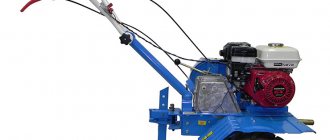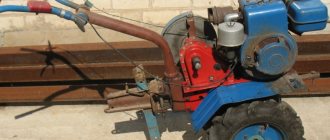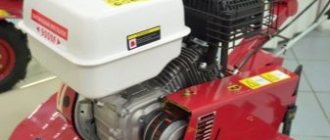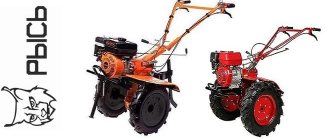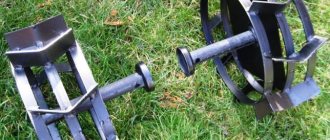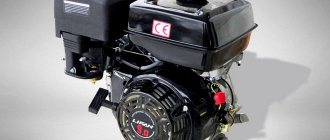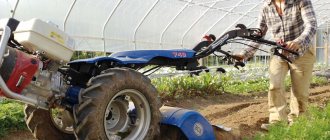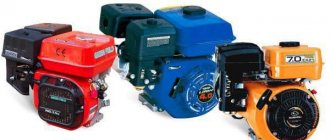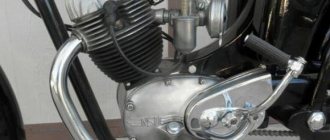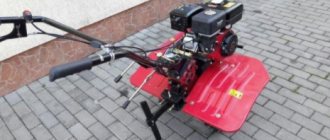In this material we will look at typical walk-behind tractor engine malfunctions and how to eliminate them.
Typically, there are two types of engine faults:
1.
The engine does not start.
2.
The engine operates unsatisfactorily (does not gain power, runs intermittently, engine stops).
If the engine does not start, then in search of faults and their further elimination, you should perform the following steps to identify the causes.
— Turning on the ignition
— Checking the presence of fuel in the tank (checking the fuel system)
— Checking the carburetor air damper (when starting a cold engine, the damper must be closed)
— Checking the flow of fuel into the carburetor.
Description
Motoblocks Bison, Cayman, Patriot, Texas, Foreman, Crosser, Viking, Forza are quite popular among buyers who value the optimal combination of price and quality provided.
Their use is advisable for a variety of agricultural work, which this equipment copes well with. Here is just an incomplete list of what these walk-behind tractors are used for:
plowing soil of varying densities;
- soil cultivation;
- mowing grass for hay;
- harvesting (beets, potatoes, etc.);
- tillage between beds, etc.
As we can see, the Bison does almost all the work typical of rural areas. This is a real helper for any farmer who spends his time usefully, i.e. cultivates the land, plants potatoes and other root crops, cares for livestock, etc.
This popularity is fully justified, because in the production of Zubr walk-behind tractors, only high-quality components that have passed special testing are used. In general, the Bison model range is quite extensive, ranging from small capacities to heavy units with power plants.
Today we are presented with Zubr diesel walk-behind tractors with a 6 hp engine, which use diesel as fuel. This circumstance allows them to show higher performance indicators than engines of similar power but running on gasoline.
In addition, diesel fuel is more economical, which is an additional plus for these walk-behind tractors. In the category of diesel walk-behind tractors with a power of 6 hp, the Zubr company represents the NT 105 model, which can cope with even the most difficult areas of land, i.e. virgin soil.
This became possible thanks to the use of a worm gearbox and a multi-disc clutch included in the design of the unit.
If you have a full-fledged plot of land with a vegetable garden and livestock, then it makes sense for you to purchase additional attachments for this walk-behind tractor, which will significantly expand the scope of its application:
- transportation of various goods;
- thanks to the use of a potato planter, you can plant potatoes in your garden quite quickly and efficiently;
- snow removal, etc.
As standard, the Zubr diesel walk-behind tractor has a rotary cutter and pneumatic wheels. Even this minimum set is enough to compete with European manufacturers, differing from them also in a more reasonable price.
For our compatriots, this is the competitive advantage that creates increased demand for Zubr equipment.
Specifications and price
The Zubr NT 105 walk-behind tractor has a 4-stroke diesel engine of the KM178F brand.
NT 105
In addition, it has the following technical characteristics:
- type of fuel used – diesel;
- engine capacity – 296 cm3;
- maximum power – 6 hp;
- fuel tank volume – 3.5 l;
- the width of the processed strip is adjustable, from 75 cm to 105 cm;
- digging depth – adjustable, from 80 to 300 mm;
- clutch type – multi-disc, in an oil bath;
- speeds - two forward and one reverse;
- total weight – 120 kg;
- fuel consumption - 1.5 liters per hour of operation;
- start type – manual;
- load capacity – 350 kg;
- cooling type – air;
- overall dimensions – 174cm/150cm/98cm.
The price of this unit is about 35 thousand rubles. This price does not include attachments, which must be purchased separately.
Self-cleaning of the unit carburetor
Do-it-yourself repair of a motor cultivator often involves cleaning the carburetor. To do this, the unit must be completely disassembled and cleaned according to the manufacturer's recommendations. The work algorithm, as a rule, is described in detail in the cultivator operating instructions. All cleaning procedures performed are aimed at restoring the uniform immersion of the carburetor float. To do this, it is also necessary to eliminate the deformation of the bracket by which the float is attached to the piston system.
Immersion adjustment is performed with both the open and closed needle valve. A screwdriver should be used to align the bracket. All manipulations must be clear and accurate.
Along with eliminating the deformation, you will also need to adjust the valves of the cultivator.
To do this, check the tightness of each of them. Completing this procedure allows you to restore the functions of the carburetor and return the amount of fuel it consumes to normal.
Adviсe
In order to repair and adjust the walk-behind tractor less often, it is necessary to protect the motor from falling. This is especially true for products with four-stroke engines. Their maximum inclination during operation cannot exceed 25 degrees. The unit cannot be tilted more than 15 degrees for a long time. Otherwise, you may be afraid that part of the engine will be deprived of lubrication. It will soon fail.
For the same reason, prolonged operation of the walk-behind tractor in idle mode is not recommended. Before starting work, you should always check that there is enough fuel and lubricating oil. These fluids need to be changed and even added only when the engine is turned off.
You cannot start the walk-behind tractor when the levers associated with the wheel drive are locked. A cold engine is started only after the carburetor air dampers are set to the closed position; Always use strictly recommended fuel.
The valves are adjusted using:
- universal wrenches;
- probes of various sizes;
- screwdriver with a flat blade.
For the intricacies of repairing the Subaru ex21 engine for the Neva walk-behind tractor, see below.
Specifications
The Master walk-behind tractor with the American Quantum engine has the following technical characteristics:
- engine power - 5.5 hp;
- tank capacity - 3.6 l;
- fuel consumption - 1.2 l/h;
- tillage depth - 25 cm;
- cutting width - 60 cm;
- weight without additional options - 45 kg;
- length with handle in working position - 130 cm;
- width - 70 cm;
- height - 98 cm;
- Dimensions in transport condition - 78x57x75 cm.
You can buy a new walk-behind tractor in Moscow for 23,000-25,000 rubles; a full set of Russian-made options will cost another 9,000-11,000 rubles.
Analogs
The following models are similar in size and technical characteristics to the Master MK-265 walk-behind tractor:
- Champion BC 6712;
- Farmer;
- Centaur;
- AL-KO MH 4005;
- Gardena EH 600;
- Daewoo Dat4555;
- Lux 1400;
- GMC-1.8;
- Bison NT 105.
The price of the product depends on the type of power plant, country of manufacture and configuration.
How to disassemble the engine
It is also necessary to disassemble the walk-behind tractor engine and inspect all components. Replace all faulty, deformed or damaged parts with similar new ones. You can also inspect the carburetor, air filter and muffler, because there may be problems such as blockage or simple contamination.
In this case, you urgently need to inspect, disassemble and clean each part and reassemble it again, but if this is not done and the engine continues to be used, despite the poor condition, then new, already faulty breakdowns may appear. There may also be problems with the clutch housing or ratchet, then you need to disassemble the starting unit and replace the faulty part with a new one. It is also advisable to inspect the cylinder-piston part of the engine, because they also tend to wear out and break; if this is the case, then they should also be replaced with new ones.
DIY starter repair
Malfunctions of the starter can also cause engine malfunction. The most common situation is when the screws securing the starter housing to the engine housing are loose. In this case, the trigger cord will not return to its original position. To fix the problem, you need to loosen the screws and adjust the position of the cord so that it easily returns to its original position (Figure 6).
Figure 6. Scheme for repairing the starter
In addition, malfunctions may be due to wear on the starter spring. It cannot be repaired, so the worn part must simply be replaced.
Adjusting the walk-behind tractor carburetor
Instability of the engine speed of the walk-behind tractor indicates that the carburetor needs adjustment. The need to perform this procedure, as a rule, arises before the start of the agricultural season, when the equipment has not been used for a long time, or after it, when the walk-behind tractor has been subjected to significant loads for a long period of time. Before proceeding with adjustments, it is necessary to warm up the engine. The actual work process looks like this:
- The screws regulating low and maximum throttle are screwed in completely, after which they are loosened by about one and a half turns.
- The engine starts and warms up for about 10 minutes.
- The lever that controls the operation of the power plant must be set to the minimum position, but the motor should not stop.
- The throttle valve adjusting screw will help you adjust the minimum idle speed so that the engine operates stable, without any extraneous noise or stopping.
- Rotating the screws makes it possible to accurately determine the amount of combustible mixture that enters the engine.
- Tightening the screw helps enrich the mixture, while unscrewing it, on the contrary, increases the volume of air entering the engine;
Using the idle screw, you should adjust the maximum idle speed. The same should be done with minimum speed, using the throttle stop screw. The essence of this adjustment is that the damper screw allows you to adjust the angle at which it is closed;
The lever responsible for controlling the engine should be moved to the “gas” position. If the operation of the walk-behind tractor still cannot be called stable, the full throttle screw is adjusted until the ideal speed is observed. However, the maximum permissible number of propeller revolutions is 2.5.
The accuracy of carburetor adjustment can also be determined by how the spark plug looks after a short period of operation under load. If the working mixture is ideal, then there will be no soot or traces of fuel on the spark plug, which indicate that the fuel mixture is too lean or, conversely, too rich. It should be noted, however, that carbon deposits or traces of fuel on a spark plug can indicate not only incorrect adjustment, but also more serious problems with the walk-behind tractor, including a faulty ignition or cooling system.
Adjusting the valve clearance of the walk-behind tractor
Over time, under significant loads, the valve clearance of the walk-behind tractor engine changes. The reason for this may be wear and tear of parts. Insufficient distance leads to the fact that the valve timing stages change significantly, as a result of which it is not possible to achieve a sufficient compression ratio, the power plant operates intermittently and does not reach the declared power. In particularly serious situations, even deformation of the valves can be observed. If the gap is too large, then significant mechanical noise is recorded, the gas distribution phases also change significantly, the valves open for too short a time, due to which the cylinder does not fill properly, power drops, and malfunctions occur. Adjustment of the gaps is necessary as soon as the engine operation becomes incorrect or occurs with significant noise. Ideally, the engine being adjusted should be cool.
So, first you need to get to the flywheel. It is on this part that the value of the top dead center is marked. The flywheel is hidden under the casing, and therefore you will have to remove it. Before removing the casing, the oil bath of the air filter is removed. You can make the task easier when removing the casing if you secure all the latches with rubber bands. Use a wrench to unscrew all the bolted connections, after which the cover can be removed without any problems.
Possible reasons
Does the walk-behind tractor start and stall? Why is this happening? There may be several reasons why a motorcycle does not start when starting. These include:
And if the jets become clogged
If the Neva walk-behind tractor does not start, the reasons may also be different. Sometimes the problem is hidden in a malfunction of the spark plugs, which play an important role in starting a carburetor internal combustion engine, or the glow plugs, which ensure the start of a diesel engine. If the igniter devices become wet, which happens due to fuel assemblies being thrown into them, the spark begins to disappear in them. In the absence of sparking, the fuel-air mixture is not ignited and, therefore, the engine cannot be started.
This problem can be solved in various ways:
If, upon inspection of a carburetor engine or diesel engine, no defective spark plugs were identified, but difficulties persist, and are also accompanied by popping noises in the muffler, it is necessary to check the functionality of absolutely all devices responsible for the flammability of fuel. A defect in them may also be a reason that the walk-behind tractor does not start. It is more correct to carry out diagnostics in a service center, where specialists will find the cause of the damage and carry out professional restoration.
Motor vehicles will not start even if there is a lack of lubricant in the engine. Certain modifications are equipped with special control sensors, which, if there is a lack of lubrication, prevent the engine from starting.
Particular attention should be paid to those machine variants that do not have such meters. Sooner or later, the degree of the lubricant mixture will reach its limit value, and if it is not compensated to the norm, this will soon lead to wear of the elements and, as a result, to a major overhaul of the engine
Walk-behind tractor design
An important driving part of the described device is the engine, which can operate on both gasoline and diesel fuel. This piece of equipment can be either two-stroke or four-stroke
A characteristic feature of these motors is that they are equipped with specially designed speed controllers that can simplify the work process. Engine power can vary from five to ten liters. It is also worth noting that specialists encounter the greatest difficulty during repairs in this part of the walk-behind tractor.
The next element of the device is the transmission, which has a number of variations:
- Serrated.
- Gear-worm.
- Belt-gear-chain.
- Hydrovolumetric.
An important component of the described device is an aggregated system, thanks to which it becomes possible to attach additional agricultural implements to the walk-behind tractor. The control of this mechanism can be located either on its handles or on the steering rods
And also in this place the clutch and gas are located. In some complex designs you can sometimes find a brake
The control of this mechanism can be located either on its handles or on the steering rods. And also in this place the clutch and gas are located. In some complex designs you can sometimes find a brake.
Preparatory operations
Place
the walk-behind tractor on a flat
surface
and clean it of dirt.
Removing the shield
, disconnect the throttle cable from
the carburetor
, loosen the bolts securing the bracket with
the drive
limit
pins .
Unscrew the 4 mounting
engine.
To facilitate
this operation, you can remove
the wings
.
Turn the engine to the left
and remove
the belt
from the crankshaft housing.
Filming
freed
engine.
Principle of operation
Cultivation of the land with a “Master” motor-cultivator is carried out as follows:
- when the engine starts, the translational energy of the piston is converted into torque and transmitted through a gearbox to two short rotors;
- each of the rotors is equipped with a long rod with a cutter placed at the end;
- when the cutters rotate, their sharp knives cut off the upper layers of soil, finely color them and mix them with the lower layers;
- such rotation of the cutters causes the cultivator to move forward while cultivating the soil;
- The depth of penetration of the knives into the soil is adjustable, and if maximum depth is required, the cultivator is weighted with lugs.
Replacement and adjustment
Quite often, unfortunately, there is a need to completely change the motor on a walk-behind tractor. When choosing a replacement device, it is recommended to give preference to products from well-known companies. Traditional prejudices about products from Chinese factories have long become irrelevant. To avoid overpaying, you need to carefully analyze how productive the power plant should be. Buying a unit that is too powerful is simply irrational.
Even if there is no talk of a complete replacement, it is important to know how to adjust the engine of agricultural machinery. It is advisable to begin disassembly only after flushing the engine and removing oil from it.
Lubricant is poured only when the engine is warmed up after a short run. Next it's time to remove the fuel tank. Sequentially remove:
- fuel supply hose;
- air filter;
- screen covering the cylinder.
Then remove the crankshaft pulley. Following the pulley, it is necessary to remove the fan, reflectors, and insulating flywheel casings. Unscrew the cover, removing the rings and coupling bodies. When the washer is removed, you can press out the flywheel using a wooden block.
Now, having dealt with the flywheel, remove the cylinder cover, camshaft and pusher. Once access to the connecting rod is gained, remove the oil sprayer and locknut. After repairing and replacing damaged parts, reassemble the engine in the reverse order. You should familiarize yourself with the diagram in advance, then there will be no errors.
Replacing damaged valves for a gasoline walk-behind tractor occurs after removing:
- gasoline tank;
- the head of the cylinder block;
- carburetor;
- muffler;
- boxes.
Installation with an elastic band is advisable if a Chinese motor is installed on domestic walk-behind tractors. Rubber cushions are often used as a platform. They can be used as parts of the front shock absorber from a classic car. Along with the need to rearrange individual parts of the walk-behind tractor engine, many people have a need to install an electric starter themselves. This starter will have to be properly connected to the battery.
The crown is attached only to the removed flywheels. First remove all interfering parts of the motor. To remove the flywheel, in many cases you cannot do without a special key. A generator and its magnets are installed in the flywheel assembly. When the terminals and contacts of the battery are aligned, you should conduct a test run of the walk-behind tractor.
Troubleshooting startup problems
Often, repair of a walk-behind tractor engine is needed because the engine will not start. If this problem occurs after winter storage, you can suspect:
- clogging of fuel or oil with water;
- oxidation of electrical contacts;
- insulation damage;
- the appearance of solid debris in the carburetor.
To prevent these problems, it is necessary to carefully inspect any connections before each start-up. If you notice the slightest tightening of the cable, especially if it is twisted, you cannot start the engine.
Even before the very first start, it is necessary to assess whether there is enough oil in the crankcase. If there is a deficiency, rapid destruction of the piston group is likely. In less than a second, the cylinders will be covered with burrs.
In this case, very serious repairs will be required, and sometimes even replacement of damaged parts. Sometimes instability in the functioning of the device is provoked by leaving the lubricant for the winter. If this is the case, in the first few moments after start-up, clouds of white smoke will pour out of the exhaust pipe. Immediately after this, the power plant will stall.
Diesel walk-behind tractors may also not start due to lack of oil. Only a few models are equipped with systems that protect against a drop in lubricant level. Most people will have to monitor the health of the walk-behind tractor themselves. It is also worth considering that failures occur due to the systematic use of unsuitable fuel. If the usual recommendations do not give much effect, you need to remove the candle and look for oil stains.
Oil, especially carbon deposits, should be carefully cleaned. Then the candle must be dried. The cylinder also needs to be dried. A very simple technique is used for “drying”: repeated sharp pulling of the starter cable. The question often arises: what to do if the walk-behind tractor does not start and smokes black smoke.
Typically, this manifestation indicates that the engine is overfilled with gasoline. You should also be wary of damage to the piston group. If both assumptions turn out to be incorrect, you need to contact the service center. Further attempts to troubleshoot problems on your own may lead to worsening damage.
When violations are associated with a lack of fuel in the working chamber, the spark plug will be dry.
You can deal with this problem if:
- pour out the old fuel;
- thoroughly clean the gasoline or diesel tank;
- clean the air filter;
- clean the fuel hose and nozzles with a jet of compressed air;
- add fresh fuel;
- After opening the fuel line, blow out the channel located in the gas tank cap.
In some cases, the failure is due to gasoline getting into the oil sump. It is necessary to check whether this problem exists after any adjustment or adjustment of the carburetor.
If the lubricant becomes clogged with fuel constantly, you need to look at the carburetor needle. It is likely that this particular node has become a weak point. It is worth noting that sometimes the walk-behind tractor engine shoots into the muffler, and perhaps even with a flame.
The most likely reason is incomplete combustion of fuel. It is provoked by:
- omissions in the ignition system;
- excessively saturated fuel mixture;
- unjustified heating of this mixture.
When the walk-behind tractor does not want to operate, interruptions in the ignition system must be looked for thoughtfully and consistently. Magneto, caps, spark plugs and high-voltage wires are examined.
Finding even minor contaminants is of paramount importance. If everything is clean, you need to inspect the ignition wire contacts. Next, check the stability of the electrodes and measure the distances between them using a special probe.
